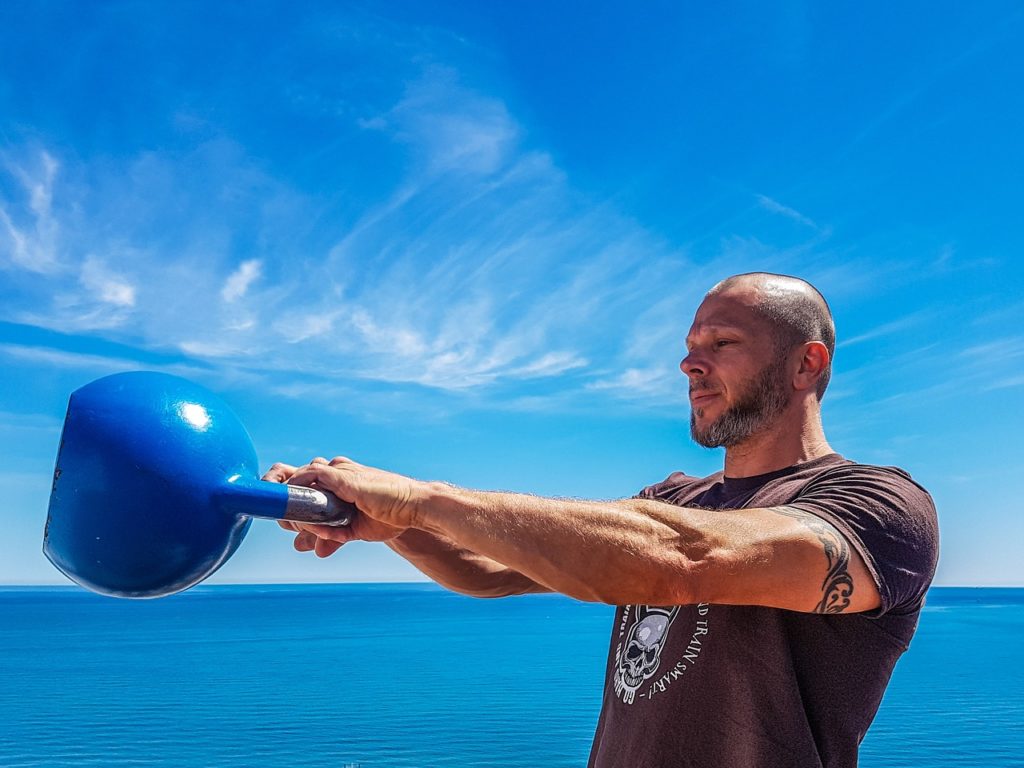Kettlebell swings are one of the most well-known and effective exercises with a kettlebell.
In this article, we answer many common questions regarding kettlebell swings. Let’s get started.

What is a good weight for kettlebell swings?
If the weight is too light or too heavy relative to your bodyweight, it won’t be very effective. For most adults, a kettlebell in the range of 16kg-32kg will be optimal.
Even really big and strong people can still get a lot out of the 16kg bell.
What is a good substitute for kettlebell swings?
Kettlebell swings are a ballistic hinge pattern, which means maximum hip displacement with minimum hip displacement.
You can replicate the pattern with anything deadlift-like, but you’ll have trouble replicating the ballistic component.
Can you do kettlebell swings with a dumbbell?
You sort of can, but I wouldn’t recommend it. It’s not very effective.
Because of the shape of the dumbbell, you have to turn the swing into more of a “squatty-swing” to get the implement between your thighs. This isn’t great for your back or knees.
Because you aren’t able to grip the implement properly, you can’t really build up the required deceleration then acceleration when changing direction.
Plus, you risk clipping the floor with the dumbbell. Or dropping it. Both are bad!
The killer app functionality of kettlebells is swings and get-ups. The movements just aren’t as good when you use other implements.
How many kettlebell swings should you do a day?
If you plan on doing swings daily, a sensible range is 75-150.
If you plan on swinging as part of a less frequent training routine, and the swing is a major movement in your training program, you might see this number in the 200-250 range or more.
How many kettlebell swings should you do per set?
Kettlebell swings are supposed to be explosive. As you tire, your explosiveness will dip.
For two handed swings 10-20 reps per set is the sweet spot.
For one handed swings keep it around 10-15 swings per hand, per set.
Why do you get back pain after kettlebell swings?
The number one cause of back pain in the swing is leaning back, and relaxing the abs.
As you cast the bell forwards out of the bottom, stand UP very hard. Become bolt upright and lock out your knees.
What muscles do kettlebell swings work?
Muscles that get the most work in the swing include all the muscles of the posterior – hamstrings, glutes, spinal erectors, and lats.
Also very much involved: your abs, your grip and your forearms.
And your heart! The heart is a muscle too.
Are kettlebell swings cardio?
If by cardio we are comparing to steady state endurance training, no.
But does the kettlebell swing have an effect on the cardiovascular system? Absolutely!
Swings are one of the fastest ways to get out of breath with a weighted implement.
Can kettlebell swings replace deadlifts?
In a similar way that a killer app of the kettlebell is the ballistic component of the swing, the killer app of a barbell is the load you can use.
The systemic impact of the loads available to you with a barbell deadlift cannot be replicated with a kettlebell.
It’s not so much one replacing the other, as they do different things.
Can kettlebell swings replace squats?
The swing is maximum hip displacement, minimum knee displacement.
The squat is maximum hip displacement, maximum knee displacement.
These are two different movement patterns. One doesn’t replace the other. They are complementary.
You don’t have to choose. Do both if you like!
Why do you get elbow pain after kettlebell swings?
Elbow pain in the swing can occur when there is a bend in the elbows. This often occurs in a subtle fashion at the top of the swing, by pulling the kettlebell towards you a little.
Keep the arms straight throughout and aim to cast the bell forwards, not up, as you accelerate out of the bottom.
Why do you get forearm pain after kettlebell swings?
Kettlebell swings are grip and forearm intensive. If you have RSI or overly tight forearms to start with, this inflammation could potentially be aggravated by swings.
Why do you get knee pain after kettlebell swings?
The most common reason for knee pain in the swing is turning the swing into a squat. Think maximum hip displacement, minimum knee displacement.
Aim to keep your shins vertical throughout.
At the bottom of the arc, you want the wrists high up the thighs. “Watch in the crotch” is a memorable catchphrase from the kettlebell community. You don’t want the bell dangling around knee height.
Much like dive bombing into the bottom of a squat, squatty-swings are a great way to aggravate your knees.
Why do you get neck pain after kettlebell swings?
Neck pain in the swing can come about if your midsection isn’t braced throughout the movement. The neck muscles take a beating at the top of the movement if your abs are relaxed.
Another potential way to aggravate your neck and the front of your shoulders is to lift the bell with your arms. The weight should be cast forward using your legs and glutes, and braked at the top by your lats.
If you feel muscular soreness (DOMS) in the front of your shoulder in the days following swings, you aren’t swinging correctly. Hire an experienced kettlebell coach to fix your form.
A correctly performed swing peaks somewhere between the belly button and in line with the shoulders. No higher.
As always, when it comes to pain, consult a medical professional.
Sources
Kettlebells improve Cardio Fitness
I’ve been in the fitness and strength training industry for nearly a decade. In that time, I’ve gained 30 pounds of muscle, written hundreds of articles, and reviewed dozens of fitness supplements. As for my educational background, I’m a currently studying for my Active IQ Level 3 Diploma in Personal Training.

